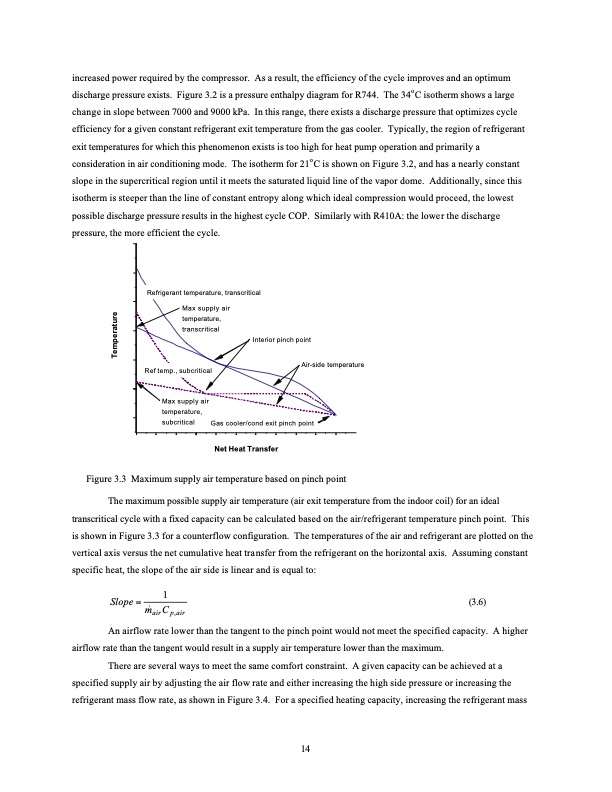
PDF Publication Title:
Text from PDF Page: 025
increased power required by the compressor. As a result, the efficiency of the cycle improves and an optimum discharge pressure exists. Figure 3.2 is a pressure enthalpy diagram for R744. The 34oC isotherm shows a large change in slope between 7000 and 9000 kPa. In this range, there exists a discharge pressure that optimizes cycle efficiency for a given constant refrigerant exit temperature from the gas cooler. Typically, the region of refrigerant exit temperatures for which this phenomenon exists is too high for heat pump operation and primarily a consideration in air conditioning mode. The isotherm for 21oC is shown on Figure 3.2, and has a nearly constant slope in the supercritical region until it meets the saturated liquid line of the vapor dome. Additionally, since this isotherm is steeper than the line of constant entropy along which ideal compression would proceed, the lowest possible discharge pressure results in the highest cycle COP. Similarly with R410A: the lower the discharge pressure, the more efficient the cycle. Refrigerant temperature, transcritical Max supply air temperature, transcritical Ref temp., subcritical Interior pinch point Air-side temperature Max supply air temperature, subcritical Gas cooler/cond exit pinch point Net Heat Transfer Figure 3.3 Maximum supply air temperature based on pinch point The maximum possible supply air temperature (air exit temperature from the indoor coil) for an ideal transcritical cycle with a fixed capacity can be calculated based on the air/refrigerant temperature pinch point. This is shown in Figure 3.3 for a counterflow configuration. The temperatures of the air and refrigerant are plotted on the vertical axis versus the net cumulative heat transfer from the refrigerant on the horizontal axis. Assuming constant specific heat, the slope of the air side is linear and is equal to: Slope = 1 (3.6) m&airCp,air An airflow rate lower than the tangent to the pinch point would not meet the specified capacity. A higher airflow rate than the tangent would result in a supply air temperature lower than the maximum. There are several ways to meet the same comfort constraint. A given capacity can be achieved at a specified supply air by adjusting the air flow rate and either increasing the high side pressure or increasing the refrigerant mass flow rate, as shown in Figure 3.4. For a specified heating capacity, increasing the refrigerant mass 14 TemperaturePDF Image | Comparison of R744 and R410A

PDF Search Title:
Comparison of R744 and R410AOriginal File Name Searched:
CR039.pdfDIY PDF Search: Google It | Yahoo | Bing
CO2 Organic Rankine Cycle Experimenter Platform The supercritical CO2 phase change system is both a heat pump and organic rankine cycle which can be used for those purposes and as a supercritical extractor for advanced subcritical and supercritical extraction technology. Uses include producing nanoparticles, precious metal CO2 extraction, lithium battery recycling, and other applications... More Info
Heat Pumps CO2 ORC Heat Pump System Platform More Info
| CONTACT TEL: 608-238-6001 Email: greg@infinityturbine.com | RSS | AMP |